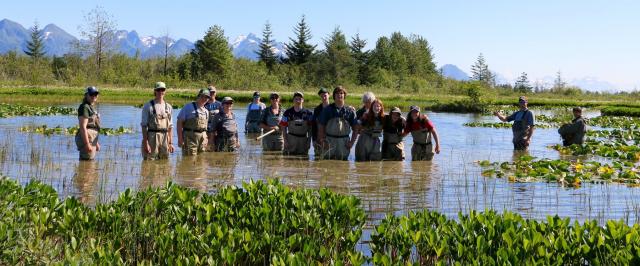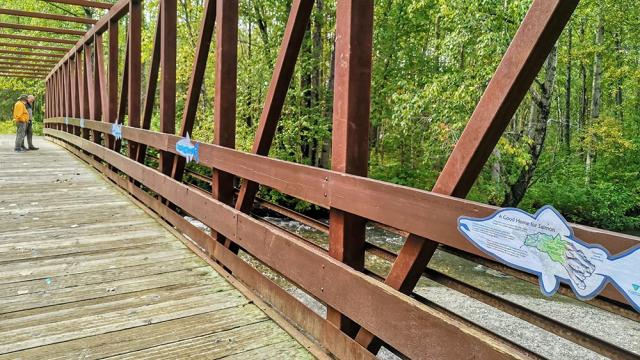Watershed Wonders
Welcome to Watershed Wonders! This unit was developed by the BLM Campbell Creek Science Center in partnership with the Anchorage School District, Alaska Pacific University, and the Friends of the Campbell Creek Science Center. Watershed Wonders is a place-based watershed curriculum for 4th-6th grade students. The unit has five learning modules that include 30–60-minute lessons with interactive activities, informational videos, virtual science labs, and hands-on reflections, as well as glossaries and assessments.
The fun, engaging modules in this unit can be used in a virtual, in-person, blended, or homeschool classroom. The modules may be taught as a comprehensive unit or facilitated individually. Modules can be guided by a teacher or completed by students asynchronously.
Watershed Wonders is aligned with Alaska state science standards and integrates Common Core math and English language arts standards and Alaska state social studies standards.
- Module 1: Watersheds
-
Big Ideas: Systems, Interconnectedness
Enduring Understandings:
- A watershed is an area of land that drains rainwater or snow melt into a river or other body of
water. - Water shapes the landscape.
- There are different parts to a watershed, and all the parts are interconnected.
- Everyone lives in a watershed.
Module Questions:
- What is a watershed?
- How does water shape the landscape?
- How are the parts of a watershed connected?
- Which watershed do you live in?
Watersheds Lesson Plan (10 minutes)
-
Objective: During the unit introduction, students will be introduced to the Watershed
Wonders unit, including the unit essential questions and the focus of each module.
Introduction (20 minutes)
-
Module 1 Introduction: What is a Watershed
During the introduction, students will review the water cycle and learn the
definition of a watershed.
Assessment (pre/post)
Glossary
Lessons
-
Lesson 1: Paper Watershed Modules (60 Minutes)
Objective: After creating a paper watershed model during the lesson, students will
accurately describe the features of their models and explain how water moves through
the landscape. -
Lesson 2: Mapping Watersheds (60 minutes)
Objective: After using maps to identify watershed features during the lesson, students
will accurately interpret a map to determine at least two key features within a
watershed. -
Lesson 3: Erosion (60 minutes)
Objective: After making observations of water erosion during the lesson, students will
make logical predictions about an erosion scenario and accurately explain why rivers
change shape. -
Lesson 4: The Campbell Creek Watershed (60 minutes)
Objective: After exploring and making observations about the Campbell Creek
Watershed on Google Earth, students will accurately describe how parts of the
watershed are connected by using their observations to write about the journey of a
raindrop from the mountains to the ocean.
Reflection: (15 minutes)
- A watershed is an area of land that drains rainwater or snow melt into a river or other body of
- Module 2: Water Quality
-
Big Ideas: Systems, Interconnectedness, Stewardship
Enduring Understandings:
- Humans and other living things depend on healthy waterways to survive.
- Human actions impact water quality in negative (e.g., urban runoff, development, dog waste, etc.) and positive (e.g., water treatment, greenbelts, etc.) ways.
- Scientists use observation, traditional knowledge, and water quality tests (e.g., temperature, dissolved oxygen, etc.) to evaluate the health of waterways.
Module Questions:
- Why is water quality important?
- How do scientists measure water quality?
- How can people’s actions impact water quality?
Water Quality Lesson Plan
Introduction (30 minutes)
-
Module 2 Introduction: What is Water Quality
Objective: After learning about water quality in the introduction, students will make logical predictions about how their community evaluates water quality.
Assessment (pre/post)
Glossary
Lessons
-
Lesson 1: Water Temperature (60 minutes)
Objective: After practicing how to create and analyze a bar graph during the lesson, students will accurately draw a bar graph representing average water temperature data and use the graph to correctly answer questions about the data.
-
Lesson 2: Dissolved Oxygen (60 minutes)
Objective: After evaluating water temperature and dissolved oxygen in the lesson, students will accurately compare the temperature and dissolved oxygen in two rivers and determine which river has healthier water quality for fish.
-
Lesson 3: Human Impacts (60 minutes)
Objective: After using tour to explore human impacts in the Campbell Creek Watershed, students will describe at least one way people affect waterways and logically hypothesize how urban runoff might impact downstream areas of a watershed.
-
Lesson 4: Healthier Waterways (60 minutes)
Objective: After using a tour of the Campbell Creek Watershed to explore solutions to human impacts in watersheds, students will brainstorm at least one action they can take to improve water quality in their watershed.
Reflection (60 minutes)
- Module 3: Creek Critters
-
Big Ideas: Systems, Interconnectedness, Diversity, Stewardship
Enduring Understandings:
- Energy and matter flow among the living and nonliving parts of a watershed.
- Aquatic habitats and riparian ecosystems provide food, water, and shelter to many living things.
- Scientists evaluate the health of waterways by identifying indicator species, such as mayflies, stoneflies, and caddisflies (aquatic macroinvertebrates).
- Aquatic macroinvertebrates have adaptations that help them survive and complete their life cycle.
Module Questions:
- How does energy flow through ecosystems?
- How do adaptations help aquatic macroinvertebrates survive?
- Why do scientists look for indicator species?
- How do scientists determine if a waterway is healthy?
Creek Critters Lesson Plan
Introduction
-
Module 3 Introduction: Creek Critters (30 minutes)
Objective: After learning about riparian ecosystems and reviewing biotic (living) and abiotic (non-living) factors in the introduction, students will identify biotic and abiotic organisms within their local riparian ecosystem.
Assessment (pre/post)
Glossary
Lessons
-
Lesson 1: Food Webs (60 minutes)
Objective: After analyzing food chains and food webs in the lesson, students will construct a logical food chain and tell a story about how energy flows within that food chain.
-
Lesson 2: Aquatic Macroinvertebrates 60 minutes)
Objective: After learning about aquatic macroinvertebrate adaptations and crafting their own macroinvertebrates, students will use their creations to describe at least three adaptations that help their aquatic macroinvertebrates survive.
-
Lesson 3: Indicator Species (60 minutes)
Objective: After students read or listen to the story about aquatic macroinvertebrate indicator species in the lesson, they will accurately summarize the story and correctly answer three questions about indicator species in riparian ecosystems.
-
Lesson 4: Campbell Creek Critters (60 minutes)
Objective: After analyzing temperature, dissolved oxygen, and aquatic macroinvertebrate biodiversity data during the lesson, students will make a conclusion about the health of Campbell Creek and provide at least two examples of supporting evidence.
Reflection (60 minutes)
- Module 4: Salmon in Alaska
-
Big Ideas: Systems, Interconnectedness
Enduring Understandings:
- Salmon have adaptations that help them survive and enable them to move from fresh water to ocean and back again.
- Salmon depend on different habitats during different parts of their life cycle.
- Salmon play an important role in riparian ecosystems (e.g., nutrient cycling, predator/prey relationships, etc.).
- Salmon encounter many challenges throughout their life cycle.
Module Questions:
- How are salmon adaptations important for their survival?
- Why do salmon need different habitats during different parts of their life?
- What are some challenges salmon face during their life cycle?
- Why are riparian ecosystems important for salmon?
- Why are salmon important for riparian ecosystems?
Salmon in Alaska Lesson Plan
Introduction (30 minutes)
-
Module 4 Introduction: Salmon in Alaska
Objective: After creating a hand diagram with the five types of salmon in Alaska in the introduction, students will use their diagram to write down five relevant questions about salmon, one on each finger.
Assessment (pre/post)
Glossary
Lessons
-
Lesson 1: Salmon Adaptations (60 minutes)
Objective: After exploring salmon adaptations during the lesson, students will write a haiku poem and a song or rap that accurately describe the form and function of two salmon adaptations.
-
Lesson 2: Salmon Habitat (60 minutes)
Objective: After learning about freshwater, estuary, and ocean habitats during the lesson, students will correctly answer three questions about salmon habitats and accurately describe at least two examples of abiotic and biotic factors in one salmon habitat of their choosing.
-
Lesson 3: The Salmon Forest (60 minutes)
Objective: After creating a model riparian ecosystem during the lesson, students will use the model to accurately describe at least three connections between salmon and riparian ecosystems.
-
Lesson 4: Salmon Life Cycle (60 minutes)
Objective: After playing the salmon life cycle game in the lesson, students will accurately synthesize their experiences from the life cycle game in a narrative story about the challenges salmon face as they grow, develop, and reproduce.
Reflection
- Module 5: Manage a Watershed
-
Big Ideas: Systems, Interconnectedness, Diversity, Stewardship
Enduring Understandings:- People modify watersheds to meet their needs.
- Human modifications to watersheds benefit people but may impact natural ecosystems.
- People use science to identify problems and take action in their watersheds.
- Land managers balance the needs of human communities and the health of natural ecosystems.
Module Questions:
- What natural resources do you get from your local watershed?
- What are the consequences of human modifications to watersheds?
- How do communities balance the needs of people and the health of watersheds?
Manage a Watershed Lesson Plan
Introduction (30 minutes)
-
Module 5 Introduction: Watershed Management
Objective: After learning about natural resources and land management in the introduction, students will identify natural resources in their community and the sources of those resources.
Assessment (pre/post)
Glossary
Lessons
-
Lesson 1: The Eklutna Watershed (60 minutes)
Objective: After viewing the slide show to explore the Eklutna Watershed during the lesson, students will correctly describe how people have modified the watershed and accurately identify natural resources and opportunities the watershed provides.
-
Lesson 2: What is a Dam (60 minutes)
Objective: After learning why people construct dams and building a model dam during the lesson, students will correctly identify one reason people might build a dam and logically explain how dams can change watersheds.
-
Lesson 3: Impacts of a Dam (60 minutes)
Objective: After recording observations and analyzing information from the Eklutna Watershed, students will accurately describe how the Eklutna Dam impacts the abiotic and biotic parts of the ecosystem and make a logical conclusion about the health of the Eklutna River.
-
Lesson 4: Balancing Act (60 minutes)
Objective: After learning about and practicing the role of a land manager during the lesson, students will synthesize perspectives from community groups related to the imaginary example watershed.
Reflection
Nature Learning Activities
Hone your watershed skills with these engaging activities:
Salmon Pop-Up Walk
Take a self-guided salmon walk on the BLM Campbell Tract in August. Signs for the walk begin near Campbell Airstrip Trailhead bridge.


